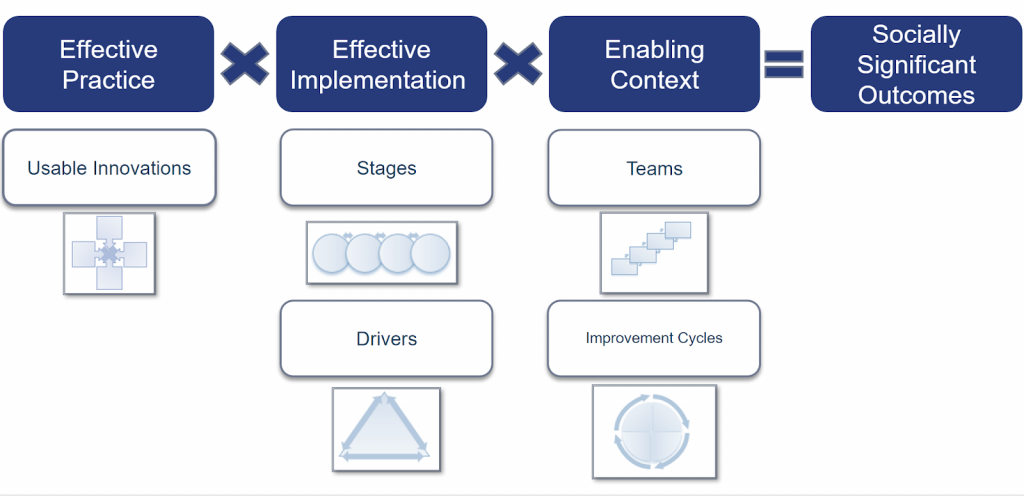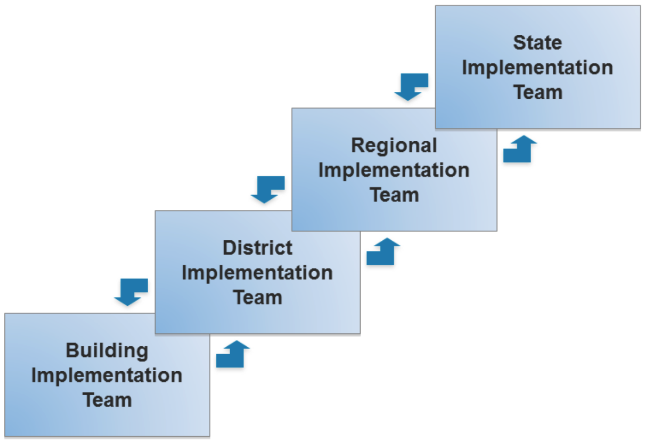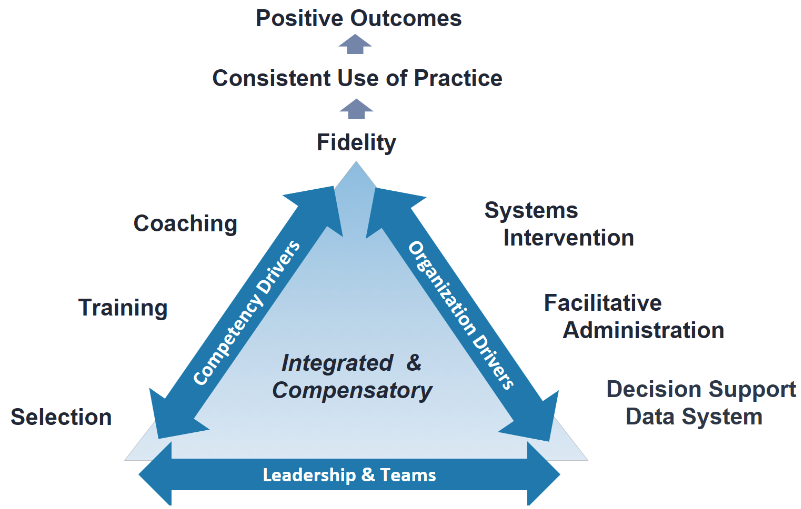Home > Implementation for Educators Blog
Long-Term Implementation Part I: Mitigating the Impact of Turnover through Active Implementation

Ensuring every student has access to high-quality education is a national priority. Yet, high rates of turnover that exist within our educational systems have an impact on our schools and student outcomes (Eiraldi et al., 2024; Jabber & Holme, 2025).
Turnover is a persistent policy concern in public education…High rates of turnover in schools have a negative impact on student achievement… (Jabber & Holme, 2025)
How significant is turnover? The data varies. According to a national survey for the 2022-23 school year (Diliberti & Schwartz, 2025), the reported rate of teachers who retired or resigned was 7%. This may not appear significant; however, examining data for the 100 largest school districts reveals that the average increased to 23%, with early-career teachers at 30% (Educational Resource Strategies (ERS), 2025). Turnover rate for principals in the national survey was estimated to be 8%, with other data indicating that nearly a quarter of principals left their buildings following the pandemic (ERS, 2023). Superintendent turnover was even higher, with a reported average of 25.5% across two school years (ERS, 2025).
Why does this matter? Turnover has a significant impact on the climate and culture within schools (Jabber & Holme, 2025). When staff members leave, it disrupts relationships and impacts trust. When experienced personnel leave, there is a loss of organizational knowledge and shared understanding, both of which are critical for effective problem-solving. Turnover in leadership can often bring additional tensions resulting from organizational restructuring and shifts in policies or priorities. Given that turnover is inevitable, let’s examine how to mitigate the impact of teacher and leader turnover through active implementation.

NIRN’s Active Implementation Formula
NIRN’s Active Implementation Formula contains core components that, when implemented with fidelity, can lead to effective and sustained use of initiatives (Fixsen et al., 2005; Fixsen et al., 2023). The core components—Effective Practice, Effective Implementation, and Enabling Context—work together multiplicatively, meaning that the implementation of one core component has a compounding impact on another, ultimately affecting the extent to which student outcomes are achieved. The Active Implementation Frameworks (AIFs) define the components within the formula, translating how to put the formula into practice. Applying the frameworks to build a system around an initiative creates an effective system for implementation, one designed to sustain amid staff turnover. Let’s take a brief look at how this is done.
Usable Innovations
Usable Innovations establish that, for an evidence-based practice to be effective, it must be teachable, learnable, doable, and assessable in practice to be effectively implemented to reach intended outcomes. In order to accomplish this, the practice must meet four criteria: having a practice that is well-defined, having essential functions within the practice identified, having these essential functions operationally defined, and having a fidelity assessment to measure the extent to which the practice is implemented as intended. Meeting these criteria ensures that the practice has the capacity to be implemented with fidelity, which is needed to ensure that it is supported and sustainable across different settings and can be maintained through staffing changes.
Implementation Stages
Implementation Stages outline the integrated, non-linear processes required to systematically implement an evidence-based practice, achieving full and effective use. The stages identify specific tasks needed to move implementation forward in iterative steps, beginning in Exploration, as the fit and feasibility of the innovation are assessed and relationships are developed. Work continues in Installation as organizational structures are built to support practitioner competencies, ensuring the practice can be implemented with fidelity in both initial and full implementation. Implementation stages help manage staff turnover by providing a clear roadmap for onboarding new staff and maintaining momentum, regardless of the organization’s stage in its change process.
Implementation Drivers
Implementation Drivers ensure that systems are developed to build practitioner competencies and organizational structures necessary to implement the practice with fidelity. Leadership and teams are foundational to making this happen, bringing their collective knowledge and commitment to implementing and supporting the practice with fidelity. Together, implementation drivers work to build a structure for continuous improvement that is responsive to changing needs within the system. Implementation drivers help buffer against staff turnover by embedding strong systems, training, and support, ensuring that effective practices remain consistent even when individual staff members change.
Implementation Teams
Implementation Teams support the full, effective, and sustained use of the innovation through a linked teaming structure. Teams are responsible for establishing communication loops, aligning resources, building the infrastructure, and addressing barriers. Effective teams intentionally implement practices that result in higher-quality implementation, which in turn can impact sustainability through effective change. An implementation team helps address staff turnover by ensuring shared ownership, continuity, and problem-solving capacity so the work doesn’t depend on any one individual.
Improvement Cycles
Improvement Cycles create data-driven processes needed for systemic and intentional change. The Plan-Do-Study-Act cycle can be used to make small incremental improvements through usability cycles or to refine and define implementation practices for ongoing implementation. Practice-to-policy feedback loops create two-way communication loops that extend from the practitioner level up through the system to policymakers and back down through the system, facilitating the sharing of implementation practices and the identification of barriers. This system of two-way communication helps to inform policy changes, align supports, and address barriers to co-create a cohesive system for ongoing implementation. Improvement cycles help mitigate the impact of staff turnover by creating a continuous learning process that captures knowledge, tests solutions, and builds organizational memory over time.
Creating a system to effectively implement an evidence-based practice requires the intentional application of all relevant implementation frameworks. Being that the Active Implementation Formula is a multiplication formula, any component not fully embedded in the process of implementation will have an impact on student outcomes. The focus and attention given to work within individual frameworks will vary and shift as you progress through implementation. Effective implementation takes time—3-5 years to reach full implementation (Fixsen et al., 2025). As the data indicates, there will be practitioner and leadership turnover. Let’s take a deeper dive into two frameworks, Implementation Teams and Drivers, to identify some activities that can help minimize the impact of staff turnover on implementation.
Deep Dive: Implementation Teams and Staff Turnover
Implementation teams bring knowledge and contextualization into implementation. Teams are composed of key individuals who bring diverse perspectives necessary to oversee, attend to, and account for core functions within the practice. Members commit their time and energy to develop collective knowledge and skills needed to continually build and sustain team capacity (Fixsen et al., 2023; Ward et al., 2023). Roles and authority within the team are defined to ensure that teams can effectively make decisions, allocate resources, solve problems, and communicate within and across the system. Engaging in these essential functions, implementation teams serve as an effective link to keep everything integrated and aligned in a purposeful and coherent way, creating stability which can serve as a buffer against turnover.

Implementation teams are established at all levels to create a linked teaming structure, linking the highest level of implementation down to the practice level. This linked structure promotes alignment and capacity building across the system. It also creates a mechanism for problem-solving, proactively addressing potential barriers as well as unanticipated challenges, and establishing communication pathways to remove barriers to the “right” level and share solutions across the system. Implementation teams at each level provide the accountability and leadership needed to maintain cohesion, consistency, and sustainability. Establishing a linked teaming structure strengthens cohesion within the system, making it more adaptive and responsive to needed change. This flexibility serves as a protective factor, such as when there is a shift in priorities due to changes in leadership, allowing the system to adapt without compromising the core practices within implementation (Horner et al., 2017; Ward et al, 2023).
Deep Dive: Implementation Drivers and Staff Turnover
Implementation requires learning a new way of working, to build capacity and develop an aligned infrastructure for systems change. Being integrated, all implementation frameworks are embedded within the drivers, and all drivers work together to build a strong infrastructure. Being compensatory, more robust drivers can support other less developed drivers. Building practitioner competencies to deliver the innovation and leadership capacity to support and monitor implementation requires training and coaching. Anticipating turnover, teams can proactively design training and coaching systems to support new staff as they integrate into the implementation.

Repeated and sustained use of an evidence-based practice requires changes in organizational structures and roles. Organizational structures encompass a range of components, including policies, procedures, staffing, resource allocation, external partnerships, and data systems. Designing and aligning these components to support effective, long-term implementation can help proactively prevent “organizational strain” caused by staff turnover (Jabber & Holme, 2025), promoting greater stability and resilience within the system.
Leaders and teams are the foundation of the implementation drivers. Implementation teams use data to monitor and assess ongoing implementation and identify barriers. Leadership is needed to support ongoing changes that align organizational structures and supports for continuous improvement, as well as to address more challenging adaptive issues. Implementation teams utilize the organizational context to develop drivers, continually examining structures and supports to adapt the infrastructure in alignment with evolving needs within the system. Engaging individuals across roles and levels of the system through distributed leadership helps build a sense of shared responsibility in decision-making and problem-solving, which can support sustainability and protect organizations during periods of turnover (Horner et al., 2017; Jabber & Holme, 2025).
“…sustained implementation requires consistent attention to organizational supports and begins with development of formal ‘leadership teams’” (Horner et al., 2017).
Closing
Education is an industry built on human capital; turnover is inevitable. Applying the Active Implementation Frameworks can create a robust system for change that can withstand turnover in practitioners and leaders. Implementation teams are key in making this happen, bringing their individual authority, knowledge, and skills to collectively build and develop leadership capacity for implementation. Intentionally focused on structures and supports needed for implementation, organizations can reduce the impact of turnover by building systems that support ongoing professional learning and sustained implementation. Reaching and maintaining full implementation takes time; the goal is to maintain processes, practice, and outcomes in the midst of “starting over” with new staff (Fixsen, Blase, & Van Dyke, 2019).
Resources
- Active Implementation Overview (Module 1)
- Handout: Implementation Teams One-Pager
- Handout: Implementation Drivers One-Pager
References
Diliberti, M. K., & Schwartz, H. L. (2025, April 14). Educator turnover continues decline toward prepandemic levels: Findings from the American School District Panel [Report]. American School District Panel, RAND Corporation. https://www.rand.org/pubs/research_reports/RRA956-29.html
Education Resource Strategies. (2025, May 1). Examining school‑level teacher turnover trends (2021–24): A new angle on a pervasive issue. Retrieved August 27, 2025, from https://www.erstrategies.org/tap/teacher-turnover-trends-analysis/
Education Resource Strategies. (2023, May 24). Concerned about teacher retention in your district? Mitigate the turnover cycle by supporting your principals. Retrieved August 27, 2025, from Education Resource Strategies website: https://www.erstrategies.org/tap/principal-teacher-retention-analysis/
Education Resource Strategies. (n.d.). Checking the data: Superintendent turnover is high and rising. Retrieved August 27, 2025, from Education Resource Strategies website: https://www.erstrategies.org/news/school-superintendent-turnover/ Education Resource Strategies
Eiraldi, R., Comly, R., Wolk, C. B., Rabenau-McDonnell, Q., McCurdy, B. L., Khanna, M. S., Jawad, A. F., Banks, J., Clark, S., Popkin, K. M., Wilson, T., & Henson, K. (2024). Preparation for implementation of evidence-based practices in urban schools: A shared process with implementing partners. Implementation Research and Practice, 5. https://doi.org/10.1177/26334895241279503 (Original work published 2024)
Fixsen, D. L., Blase, K. A., & Van Dyke, M. (2019). Implementation Quotient. Active Implementation Research Network. Retrieved from https://static1.squarespace.com/static/6516b49bc5e0e32ff9cd1e2f/t/65ba2e1f24a59205375d3161/1706700320821/ImplementationQuotientforOrganizations‑1.pdf
Fixsen, D. L., Naoom, S. F., Blasé, K. A., Friedman, R. M., & Wallace, F. (2005). Implementation research: A synthesis of the literature. Tampa, Florida: University of South Florida, Louis de Parte Florida Mental Health Institute, The National Implementation Science Research Network (FMHI Publications #231).
Fixsen, D. L., Van Dyke, M. K., & Blase, K. A. (2024). Implementation science for evidence-based policy. In B. C. Welsh, S. N. Zane, & D. P. Mears (Eds.), The Oxford Handbook of Evidence-Based Crime and Justice Policy (pp. 58-75): Oxford University Press.
Harbatkin, E., & Henry, G. T. (2019, October 21). The cascading effects of principal turnover on students and schools [Working paper]. Brookings Institute. https://www.brookings.edu/articles/the-cascading-effects-of-principal-turnover-on-students-and-schools/
Horner, R. H., Sugai, G., & Fixsen, D. L. (2017). Implementing effective educational practices at scales of social importance. Clinical Child and Family Psychology Review, 20(1), 25–35. https://doi.org/10.1007/s10567-017-0224-7
Jabbar, H., & Holme, J. J. (2025). Teacher turnover, social capital, and improvement: How instability disrupts schools. Educational Evaluation and Policy Analysis. https://doi.org/10.3102/01623737241311304
National Implementation Research Network. (2023, January). Active Implementation Overview (Module 1). AI Hub, State Implementation and Scaling‑up of Evidence‑based Practices (SISEP), Frank Porter Graham Child Development Institute, University of North Carolina at Chapel Hill. Retrieved August 27, 2025, from https://implementation.fpg.unc.edu/resource/1429/
Ward, C., Ihlo, T., Ryan Jackson, K., & Farmer, S. (2023). Effective implementation capacity to impact change within state education systems to support students with disabilities. Journal of Disability Policy Studies, 34(2), 104–114. https://doi.org/10.1177/10442073221096392

